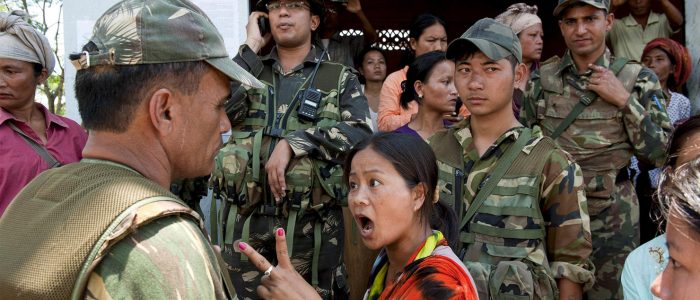The Manipur crisis is an example of the fragile ethnic landscape in India, especially after BJP came into power in 2014. The crisis unfolded on 3 May 2023 after protests against a court order that would effectively alter the state’s demography. Manipur state is situated in the northeast of India, bordering Myanmar. It is a mountainous area where the central valley is dominated by Meitei ethnic group, who are predominantly Hindu, while the mountains are inhabited by tribal communities, Kukis and Nagas, who are Christians. There is a small Muslim population as well. This diverse ethnic spectrum with different religions is also a source of contention in the region. Meitei is a numerically dominated group that makes up 54% of the region’s total population, the tribal community 40%, while the rest are other small groups. Due to their tribal lifestyle, the central government gave them Scheduled Tribes (ST) status to protect their distinct lifestyle. This ST status gives them certain privileges, like an exclusive land authority in the mountains. The bone of contention comes from this exclusivity since the valley only amounts to 10% geographical area of the state where the Meitei, who are the majority, lives. This hill-valley divide is the main cause of hostilities in the state.
The violence erupted in May after the Manipur high court directed the central government to send a recommendation to the Union Ministry of Tribal Affairs to proceed with the recommendation to add Meitei to the ST list. The tribal student affairs group called for a protest that soon escalated into a violent conflict between state security groups and tribal militias. The tribals protested against Meitei’s ST status as the Meitei group is historically more developed, and the main focus of funds has always centred on the valley. Out of 60 seats in the Manipur assembly, 40 MLAs are selected from the valley, which gives them superior authority in state legislation, while the tribal groups have to make alliances to sit in the assembly.
The central government has also played a significant role in the ethnic divide of the state. The majority ruling party in the state is BJP, with their member as the Chief Minister. Since the BJP came to the main stage in Manipur, the Hindu nationalist fervour has also heightened in the northeastern state. During the protests, some vandal groups set fire to the churches, which soon embroiled in a public riot. The Christian groups set ablaze temples while the Meitei people attacked and burnt down scores of tribal villages. During all this turmoil, the central government took no decisive action against the communal violence that forced thousands of tribals to seek shelter in camps.
Even the Chief Minister of Manipur only accused the Kuki militias of terrorism while turning a blind eye to the communal riots by Meiteis and the looting of tribal villages.
All the while, the tribal community has also faced persecution from the state. The government declared the mountainous zone as strictly governmental property to preserve the forest and protect the environment. There have been numerous accounts of forceful evictions and seizure of property, using this scenario as a pretext. The government has raided the tribal community to prevent illegal poppy cultivation, which is the main source of income for the Kukis. This discriminatory policy is tantamount to the divide policy used by BJP against the minorities as the tribal community is majority Christian. The central government has remained docile to all these dissimilatory policies and even ordered evictions to protect the reserved forest source home to tribals for many centuries.
Despite their ally Kuki members in the Manipur government, the centre is accused of exacerbating the tensions by promoting one group while sidelining the other, especially when the other group is a religious minority. Instead of addressing the people’s grievances, an indefinite curfew has been imposed, and the internet has been banned. The lockdown has also caused a food shortage and a lack of communication. This action may appear as a way to contain violence, but it has seemingly added to the problems for Kukis. As thousands of people have fled their villages and hometown, this communication lockdown has created further tensions as people are unable to ensure the safety of their families.
The inability of the Manipur government to contain the violence also shows the fault lines in BJPs politics of “us” versus “them”. In 2002, it was Prime Minister Modi who was then Chief Minister of Gujrat when riots spread out in the state resulting in the deaths of many Muslims. In yet another burning state, BJP is in power. This time again, it is the majority Hindu populace armed against the minority. The central government and Manipur, both ruled by BJP, have failed to address the primary cause of the whole fiasco: the forceful eviction of people from their rightful habitat, enacting discriminatory laws, and promoting majority group that is already privileged to further their own political agenda. The communal divide has become so apparent that even a BJP MLA of the Kuki community was attacked by a violent mob and left critically injured. Even the Chief Minister of Manipur only accused the Kuki militias of terrorism while turning a blind eye to the communal riots by Meiteis and the looting of tribal villages.
This alleged one-sided narrative has been the modus operandi of BJP’s extremist Hindutva politics. The central government’s criminal silence over the Manipur tragedy speaks volumes of their so-called democratic system. Instead, India is turning into a fascist majoritarian state where the rights of the minority have become secondary, even if they are an apparent ally of the governmental apparatus. The Manipur crisis illustrates the fragile fault lines of India’s diverse ethnic spectrum under the fallout of BJP’s extremist politics.
